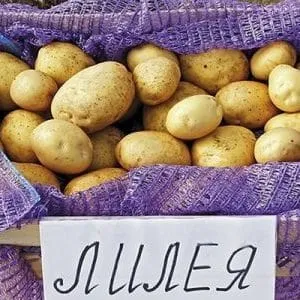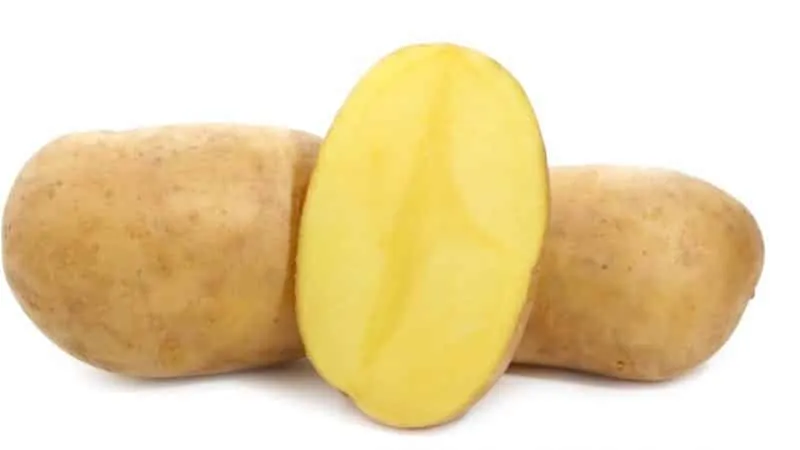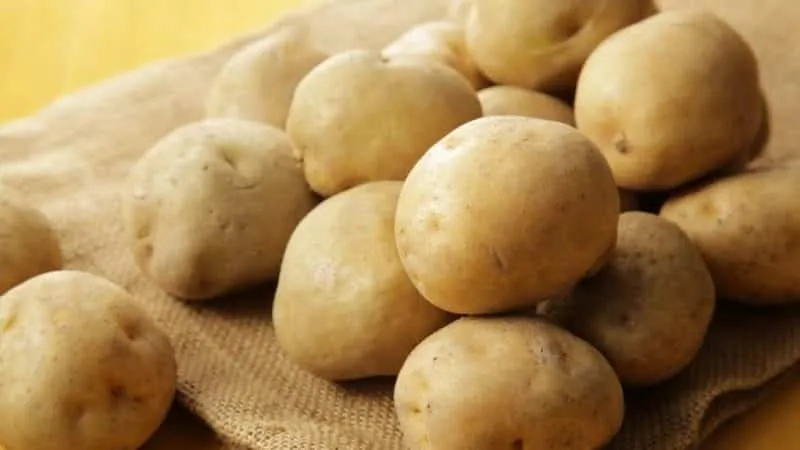Potatoes from Belarus are rightfully considered among the best in the world. A well-known and proven variety of Belarusian potatoes is Lileya. This delicately named potato stands out for its excellent taste, high yield, and large size.
Let’s take a closer look at its characteristics and cultivation tips.
Table of contents
Description of the Plant Variety
Like any other variety, Lileya has certain distinctive features. Let’s examine its composition, origin, and cultivation specifics.
Origin and Development
This is an early table potato variety. Initially, it was called Lileya Belarusian, but later it became widespread in several European countries, and in 2008, its official name was shortened to simply Lileya. It is cultivated in Northern, Central, and Western Europe.
Chemical Composition
The composition of this variety is similar to others. Its unique feature is its higher sterol content.
The composition also includes:
- amino acids;
- carotene;
- organic acids;
- starch (about 15% per tuber).
Lileya is rich in vitamins A and B, making it an excellent choice for those who follow a healthy diet.
Characteristics and Appearance
The plant has a typical appearance — a medium-height, moderately spreading bush. The stem is straight with abundant green foliage. The leaves are medium-sized, green, with slightly wavy edges. The flower corollas are quite large and light in colour.
Each cluster forms 8 to 15 tubers, which are oval or round in shape, weighing about 200 g each. Lileya tubers are generally uniform in size, with small ones being rare. The skin is yellow, dense, and smooth. The flesh is light yellow and does not darken when cut or boiled. The eyes are small, few in number, and shallow.
The commercial yield is high — between 250 and 400 centners per hectare.
Suitable Growing Regions
This variety is cultivated across Europe. It shows excellent yields not only in the south but also in cooler regions like Scandinavia — with proper farming techniques, yields can reach 650 centners per hectare.
The variety is also suitable for northern regions. It adapts well to colder climates, though it does not produce the same yields as in southern areas.
How It Differs from Other Varieties
Lileya stands out from other varieties in several ways:
- higher resistance to adverse weather conditions;
- larger tubers;
- visually appealing, with minimal defects;
- adaptable to different soil types;
- maintains high yields over multiple growing seasons;
- bred specifically for culinary use.
These advantages make Lileya a superior choice compared to other potato varieties.
Lili and Lileya
There is a potato variety with a similar name to Lileya. Lili is a mid-early table variety. Its yield is also high, but it was developed relatively recently and has not yet gained the same widespread popularity as Lileya.
Moreover, it differs in appearance. Lili tubers are oval, medium or small in size, with numerous eyes. Its taste is considered average. It is more common in northern Europe and is resistant to diseases and frost.
Key Advantages and Disadvantages of the Variety

Lileya is a widely recognised favourite. It’s no surprise that it has become so popular and is in high demand among gardeners.
Experts highlight the following advantages:
- high yield;
- resistance to varying weather conditions;
- versatility of tubers;
- attractive appearance;
- excellent taste and marketability.
It has almost no drawbacks, except for susceptibility to pests and diseases. However, these issues are common to most potato varieties. With proper care, the risks of infection and pest attacks are minimised.
Planting and Growing Features
Even a beginner can grow this undemanding variety. However, it’s important to follow basic farming practices and consider weather conditions. Let’s examine the cultivation specifics in detail.
Preparing for Planting
First, choose the right seed potatoes. Select medium-sized, evenly shaped tubers without damage or dark spots. Chemical disinfectants are not strictly necessary, but growth stimulants (such as "Epibrassinolide" or "Bioglobin") can be beneficial.
About a month before planting, sprout the potatoes in a well-lit area. Lightly moisten the tubers by spraying them with water. Once sprouts reach 1.5 cm in length, the potatoes are ready to be planted in open ground.
Planting Time, Scheme, and Rules
Following a specific planting scheme ensures the formation of larger and more numerous tubers.
Plant potatoes when the soil is sufficiently warm. Measure the temperature at 8 cm depth — it should be at least +10°C.
The recommended planting scheme is 60 cm × 30 cm — avoid planting bushes too close together, as they may shade each other. Some gardeners use an 80 cm row spacing to increase yield.
Planting depth should be around 10 cm. Larger tubers can be planted deeper, while smaller ones should be closer to the surface. In dense soil, a depth of 5–6 cm is sufficient.
Growing Specifics
Fertilisation can increase yields by 20–40%. A mineral complex containing all essential nutrients is ideal. Nitrogen fertilisers can also be used to accelerate foliage growth. However, excessive fertilisation is harmful — 2–3 feedings per season are enough.
Important. Monitor weather conditions. In rainy seasons, additional watering is unnecessary, as it may cause tubers to rot.
Care Tips
In addition to watering, regular weeding and hilling are essential. Treat the beds three times per season, thoroughly removing weeds. Mulching with grass or straw is recommended. During this period, fertilisers such as potassium and magnesium-based mineral supplements mixed with poultry manure can be applied.
Experienced farmers know that regular soil loosening reduces weed growth. Use a rake or harrow, working diagonally to avoid damaging the tubers. This method not only removes weeds but also improves soil aeration and moisture retention.
Watering Schedule
Excess moisture can hinder growth. Watering depends on weather conditions. In dry periods, water 1–2 times per week. Increase water supply when flowers form.
Water either early in the morning before the sun gets too strong or late in the evening.
Fertilisation
Fertilise the plants twice after planting. Spray the bushes with superphosphates and use growth stimulants three times during the growing season. The first application is during leaf formation, the second when buds appear, and the third during tuber development.
Disease and Pest Control
Colorado beetles are equally harmful to all potato varieties. Remove insects manually and spray the plants with onion peel infusion as a preventive measure.
Wireworms also attack potatoes. To eliminate them, use insecticides and regularly loosen and hill the beds.
Late blight is a common disease, especially in rainy periods. To prevent it, spray the plants with "Phytophthora inhibitor". If infection occurs, treat the bushes for 10 days with a copper sulphate solution (2 g per 10 litres of water).
Harvesting and Storing the Crop
To prevent spoilage, potatoes must be harvested and stored correctly.

When and How to Harvest
Early tubers can be sampled in July, but the main harvest occurs in August. Choose a dry day for harvesting. Set up a shaded, well-ventilated area to lay out the dug-up potatoes. After three weeks, sort the tubers.
Storage Tips
Store potatoes in a dry, cool place at +2 to +5°C. The best containers are mesh bags or wooden crates. The variety has a shelf life of over 90%.
Potential Growing Challenges
Lileya is one of the easiest varieties to grow. However, challenges may arise due to improper care.
This variety requires proper and regular watering, as well as protection from pests. Wireworms and Colorado beetles can damage the crop, so remember to hill the plants, apply preventive sprays, and manually remove insects.
Tips from Experienced Gardeners and Reviews
Here are some tips from experienced farmers who have grown Lileya:
- Lileya thrives with consistent watering. If the weather is favourable, the potatoes will grow well without additional fertilisation.
- Apply foliar fertilisation twice a month by spraying the bushes with a superphosphate solution.
- For storage, mesh bags are better than sacks or boxes.
There are many reviews about the Lileya variety.
Sophie, France: "I decided to try the Lileya variety for the first time. Planting was hassle-free, and it grows well in our climate. The taste is wonderful — the potatoes are firm and large. Perfect for soups, mashed potatoes, and fries."
Mark, Germany: "I’d heard many good things about Belarusian potatoes. Lileya lived up to the hype. The tubers are uniform, with no rot. It grows well, resists diseases and pests, but requires consistent care. Overall, I’m very satisfied and now grow only this variety."
Conclusion
Lileya is a true achievement of Belarusian breeding. It thrives in various climates, is low-maintenance, and produces abundant yields. Thanks to its excellent taste, it is widely used in cooking and the food industry.







